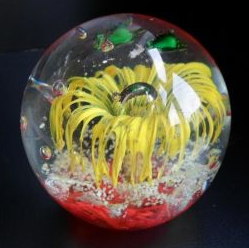What is a Paperweight?
by Steve Richardson, PCA Outreach Director
If you have been collecting for even a short time, you have probably heard that question a few times. If you haven’t heard it out loud, you’ve at least run across people who give you a blank stare of polite puzzlement when you tell them what you collect in your spare time.
 The confusion starts with the word “paperweight” itself. Even the earliest modern paperweights were designed more as decorative objects than as utilitarian tools to keep papers from blowing off your desk. It might have been more helpful to refer to them as glass sculptures or miniature worlds or – as some artists today call them – orbs.
The confusion starts with the word “paperweight” itself. Even the earliest modern paperweights were designed more as decorative objects than as utilitarian tools to keep papers from blowing off your desk. It might have been more helpful to refer to them as glass sculptures or miniature worlds or – as some artists today call them – orbs.
 The more fundamental problem, though, is that many things have been called paperweights. There are also many small objects – think snow globes or pet rocks – that fit the broad definition of being mildly artistic and commonly found on desks. I find it difficult to explain why those don’t belong in my paperweight collection, at least without sounding a bit snobbish.
The more fundamental problem, though, is that many things have been called paperweights. There are also many small objects – think snow globes or pet rocks – that fit the broad definition of being mildly artistic and commonly found on desks. I find it difficult to explain why those don’t belong in my paperweight collection, at least without sounding a bit snobbish.


Part of the problem is that we each have personal feelings about what is “artistic”. We build a mental hierarchy that includes everything from the Mona Lisa to our grandchildren’s refrigerator art, and we draw a line that puts pet rocks on one side and real paperweights on the other. Another part is that many objects that PCA members collect are, frankly, expensive. They are items that people buy with discretionary income. If you have collected even a few costly paperweights, you may appear to be in different circumstances than people who can only afford snow globes. This is very delicate territory, particularly when we are debating about where mass-marketed Chinese weights and some Murano weights fall in the spectrum.



 The confusion starts with the word “paperweight” itself. Even the earliest modern paperweights were designed more as decorative objects than as utilitarian tools to keep papers from blowing off your desk. It might have been more helpful to refer to them as glass sculptures or miniature worlds or – as some artists today call them – orbs.
The confusion starts with the word “paperweight” itself. Even the earliest modern paperweights were designed more as decorative objects than as utilitarian tools to keep papers from blowing off your desk. It might have been more helpful to refer to them as glass sculptures or miniature worlds or – as some artists today call them – orbs. The more fundamental problem, though, is that many things have been called paperweights. There are also many small objects – think snow globes or pet rocks – that fit the broad definition of being mildly artistic and commonly found on desks. I find it difficult to explain why those don’t belong in my paperweight collection, at least without sounding a bit snobbish.
The more fundamental problem, though, is that many things have been called paperweights. There are also many small objects – think snow globes or pet rocks – that fit the broad definition of being mildly artistic and commonly found on desks. I find it difficult to explain why those don’t belong in my paperweight collection, at least without sounding a bit snobbish.
